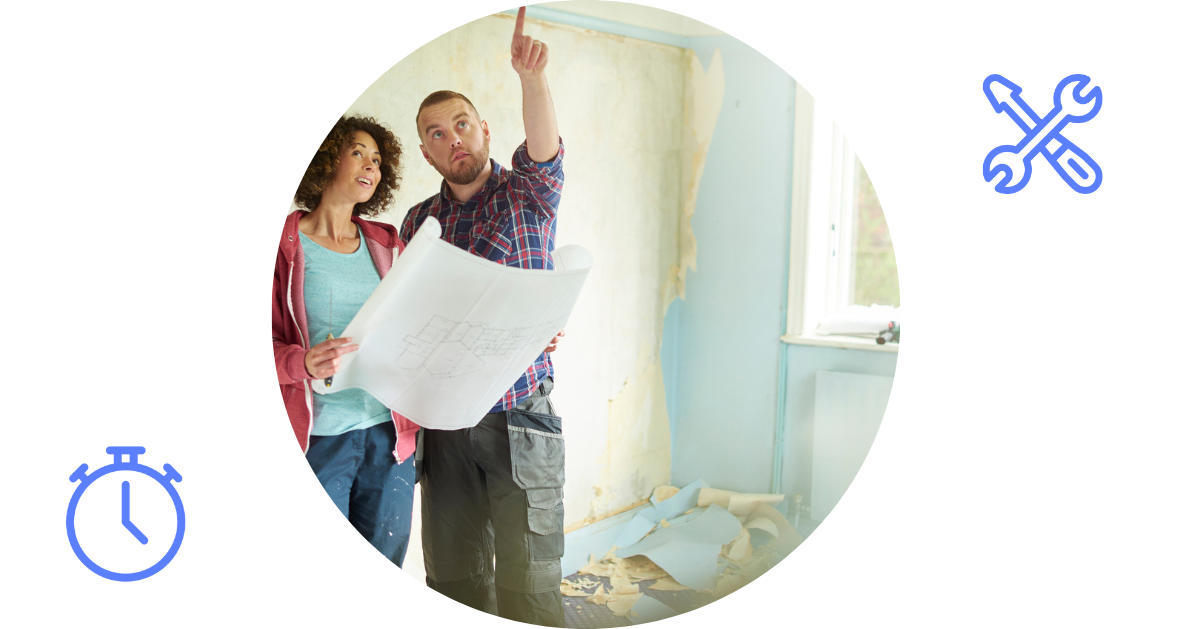Flipping Homes In An Uncertain Market

Navigating an uncertain market? Deciding to fix and flip can be a tough call.
Why? Because the profit from flipping homes in the U.S. dropped to 27.5% last year — the lowest return on investment since 2007.
This drop highlights the current market risks, but fixing and flipping have always had their share of challenges.
In fact, nearly 90% of investors have faced losses of $200,000 or more on a single investment at some point in their journey, and almost 42% have lost more than they’ve earned.
The biggest pitfalls? Rising costs, market saturation, economic uncertainty, poor property selection, and underestimating renovation expenses — to name a few.
But here’s the upside: When done right, flipping can bring incredible rewards, not just for you and your business but also for future homeowners searching for their dream home.

So, how can you tilt the odds in your favor and streamline your investment process?
By building and following a data-driven flipping framework designed to help you stay immune to even the most uncertain market conditions.
In this guide, we’ll cover:
Questions to Ask When Evaluating Flipping Deals

Every real estate investor is familiar with the thrill of starting a new deal — the rush of adrenaline and the excitement of what could be.
Yet, as exhilarating as this moment is, it often leads to focusing solely on the positives while conveniently overlooking the potential challenges of a new flip.
Even though it might not be the most enjoyable part of the process, it’s crucial to pause and ask the right questions before jumping into our next venture.
Why? Because 45% of investors say, a terrible investment nearly ruined them financially.
So, before jumping into your next big deal, ask yourself these key questions to ensure you’re making a wise investment.
Before tackling your next flip, let’s break down what you need to consider.
Question #1: Does this flip align with my investment goals?

To determine if a property is a good investment, evaluate its potential for appreciation.
Research historical property value trends in the area to estimate future value increases.
For example, if properties appreciate by 5% annually and are priced at $350,000, they might be worth $400,000 in a year.
Next, account for any repair or renovation costs. Subtract these costs from the purchase price to get the property’s adjusted value.
For instance, if repairs are estimated at $20,000, the adjusted price would be $330,000.
After? Evaluate the property’s rental income potential by comparing it to local rental rates. If similar properties rent for $2,000 monthly, that’s $24,000 annually.
Calculate the rental yield by dividing this income by the adjusted purchase price. For a property bought for $330,000 with a $24,000 annual rent, the gross rental yield would be about 7.3%.
Consider local market conditions, including rental occupancy rates and demand. A high occupancy rate, such as 95%, suggests strong demand and a lower risk of extended vacancy.
Finally, compare the property’s price to the local median sale price. It could be a bargain if it is priced significantly below the median (e.g., $350,000 vs. a $400,000 median), provided it meets your repair and rental income expectations.

With this in mind, you can choose between two main strategies for making the most of your investment:
Fix + Flip: This strategy involves buying a property, making improvements to increase its value, and then selling it for a profit.
Buy + Hold: This approach involves purchasing and keeping a property for extended periods, renting it out to generate steady income, and potentially benefiting from property appreciation over time.
Recommendation: If you’re looking for a faster return and can manage renovation projects efficiently, Fix + Flip might be a better choice (more on this later).
Question #2: How am I going to finance it?

Assess your financing options, including traditional mortgages, private loans, or hard money loans.
With a national average rate of 6.93% for 30-year fixed loans, traditional mortgages offer long-term stability and lower monthly payments, making them suitable for rental properties where steady cash flow is essential.
However, their higher rates may be less attractive for short-term investments. In such cases, private loans could be a better option.
Why? Because private loans offer flexibility and quicker access to capital than traditional mortgages.
They are ideal for urgent deals or unique situations but come with higher interest rates and shorter terms. They also work well for short-term projects or flips.
Lastly, hard money loans are known for their high interest rates and fees. However, these loans are secured by the property’s value and offer fast funding.
Hard money loans are best for investors looking to flip properties quickly, where rapid returns can offset the higher cost.
Question #3: How long can I afford to own it?

Understanding what it takes to own a property begins with the initial costs.
Think about the purchase price of the home — say, $400,000.
On top of that, you’ll need to account for closing costs, which usually fall between 2-5% of the purchase price.
For a $400,000 home, you could be looking at an extra $8,000 to $20,000.
Next, factor in ongoing expenses.
Your mortgage payments on a $320,000 loan (after a 20% down payment of $80,000) at a 6.5% interest rate would be around $2,000 monthly.
Additionally, property taxes are estimated at about $3,000 annually, and insurance is around $1,000 per year.
Maintenance costs should also be considered, typically about 1% of the home’s value annually. For a $400,000 property, this amounts to $4,000 per year.

If you hire a property manager, expect to pay 8-10% of your rental income for their services.
Utilities, if not covered by tenants, might cost around $200 per month.
Also, budget for repairs and renovations based on the property’s condition and your plans.
Finally, evaluate the property’s rental income potential or resale value. Ensure that these potential earnings justify the investment and that all costs fit within your budget.
From assessing your long-term satisfaction to crunching the numbers and exploring financing options, getting these answers right can mean the difference between a profitable flip and a costly mistake.
Addressing these factors proactively helps mitigate risk and prepare for potential challenges.
By evaluating every aspect, you make informed decisions that enhance your chances of success.
Your Data-Driven Flipping Strategy for Today’s Market

Now that you know the key questions, let’s explore what it takes to flip properties in today’s market successfully.
We’ll take a step-by-step approach to helping you buy properties at a great price, sell them for a profit, and maximize your returns — all while revitalizing homes in your community.
Research Market Conditions and Construction Costs

The best time to start house flipping?
When home prices are low, there’s high demand from buyers, and houses sell quickly.
However, if starter home prices are incredibly high, it’s best to pause and reassess.
Why? Because high prices could limit your returns and burden you with hefty mortgage payments on top of significant renovation costs.
Experienced flippers estimate repair costs and set aside a buffer for unexpected expenses. But even they didn’t see the 20% jump in construction material costs from January 2021 to 2022 coming.
Even though home price increases slowed in 2023, construction costs are still high. Delays in permits or material deliveries can eat your profits, so sticking to predesignated timelines is essential to avoid overpaying on mortgage and insurance.
The silver lining? Almost 68,000 U.S. homes were flipped in the first quarter of 2024, which is about one out of every 12 homes sold.
This figure is up from 7.7% of all home sales in Q4 of 2023, marking the second consecutive quarterly increase.
Even better? This year, flippers typically make a gross profit of over 30% on each deal.
Pick Your Property

You should aim for the worst house on the best street.
Issues like lousy floor layouts, outdated kitchens, and worn-out bathrooms can all be renovated and improved — your location can’t.
We recommend choosing a property in a great location rather than one that requires the least amount of work.
Because even the most beautifully renovated home will face challenges in finding a buyer if it’s situated in a less desirable area with low-rated schools and undesirable neighborhoods.
The key? Identify neighborhoods with solid, lasting value. Look for signs that will boost property prices, such as new shops, restaurants, and reputable schools nearby.
Review current or upcoming city plans as a valuable resource to understand community improvement priorities. New projects like parks and road upgrades reflect the city’s dedication to enhancing the neighborhood.
Negotiate the Right Purchase Price

Got your ideal property? Now it’s time to secure it at the right price.
Let’s dive into the golden rule, also known as the 70% rule, in real estate flipping.
The 70% rule states that house flippers should spend no more than 70% of what they think the property will be worth after repairs.
Whatever you do, this classic method requires caution. Given the wild real estate market, you don’t want to bid too low.
Use it as a starting point, but also consider other factors like nearby property values and current interest rates.
Secure Your Financing

Funding a flip doesn’t require a fortune — and in some cases, you might not need to invest any of your own money.
You have a few choices to seal the deal, like tapping into your savings or a HELOC (Home Equity Line of Credit) to borrow against your home’s equity.
Bank loans are another option, and there are several types to choose from.
For instance, bridge loans and hard money loans can provide quick cash to help you buy a property quickly.
Bridge loans are short-term loans designed to cover the gap between buying a new property and selling an existing one.
Hard money loans are also short-term but are based more on the property’s value than your creditworthiness, making them a good option for fast funding.
Both types of loans often come with set deadlines for selling the property, so you must carefully plan your project and timeline.

Are you unsure which option is best for you? Discuss the details with your lender and work out your estimates for the amount needed and your listing timeline.
Ask questions like:
“What types of loans do you offer, and what are their interest rates and terms?”
“What fees are associated with each loan, and are there any prepayment penalties?”
“What is the required down payment, and how much can I borrow based on my financial situation?”
Allow Time for Renovations

After securing your financing, it’s time to start the project.
During the renovation, keep the lines of communication wide open with your contractor and repair team.
This way, you’ll stay on track with your timeline and be aware of any surprises or unexpected costs.
But it’s not just about saving money. Focusing on quality can actually lead to a higher sale price when flipping houses.
The National Association of Realtors advises against contractors who promise cheap rates and fast results.
Instead, look for a partner who values high-quality work and respects deadlines. Get estimates early on so you can understand both cost and timeline.
Another recommendation? Take contractors along when you tour the property. This way, you’ll have a clearer picture of all your upfront costs before you sign anything.
Sell Your Renovated Property
Thinking about selling your flip on your own?
Sure, you can go the FSBO (For Sale By Owner) route, but partnering with a real estate agent can expand your listing’s visibility and save you time and headaches in negotiations.
When your agent lists your property on the MLS, it gets syndicated to major sites like Redfin, Zillow, and more.
This means more eyes on your property, which can help you find the right buyer faster and get a better price.
In fact, FSBO homes sell for about 30% less than similar homes listed on the MLS.
Plus, 73% of buyers believe they or their agent can negotiate a better deal with an FSBO seller.

As mentioned earlier in the article, we recommend focusing on Fix + Flip versus Buy + Hold when considering investment strategies.
Why? Because Fix + Flip can deliver quicker returns and potentially higher profits when done right.
On the other hand, Buy + Hold can serve as a reliable backup, offering steady rental income and long-term value growth if the market isn’t ideal for a fast sale.
Remember that if your Fix + Flip fails, you need to be prepared.
Ask yourself: if I can’t flip the property and end up underwater, can I afford to take the loss? What might that loss look like?
To minimize risk, reduce the time it takes to flip the property. The faster you can sell, the less risk you take.
Flipping a property in under six months is ideal, while holding onto it for six to twelve months can be risky.
Why? Because the longer you hold onto the property, the more you risk market changes, higher costs, and potential drops in the property’s value, which can hurt your profits.
Flipping With PropertyRadar

Now that we’ve outlined the steps for a successful flip let’s chat about finding your next flip, streamlining your research, and maximizing your returns.
How? Through public records.
Public records offer detailed insights into individuals and properties like neighborhood comparables, ownership details, transaction histories, and demographics.
This valuable information helps you pinpoint the best properties to flip and invest in and allows you to tailor your marketing strategies to attract potential buyers and secure new leads effectively.
The good news? You can access public records through local government offices or online databases that simplify the process.
Our recommendation? Use data-driven lead generation platforms like PropertyRadar to connect with property owners at scale.
PropertyRadar taps into the extensive information in public records, covering over 150 million properties, 250 million individuals, and more than 1 billion phone numbers and emails.
This data is organized in a powerful, sophisticated, and easy-to-use database that is available via desktop and mobile apps.

Better Yet? PropertyRadar offers top-notch filtering options, letting you fine-tune your searches with great precision and detail.
You can use various criteria, filters, and settings to narrow down the exact properties and owners you’re interested in.
Want to find a vacant home for your next flip? Or maybe you’re focused on zombie foreclosures. Whatever the case, you can create targeted lists of properties in optimal areas for investment and adjust the criteria to fit your needs.
Plus, when you turn on monitoring, your lists automatically update with new properties and information that match your criteria.

Found your property? You can use PropertyRadar to help connect with other flippers who may be willing to share their contractor contacts.
Enter your city in your PropertyRadar account and navigate to ‘Quick Lists > Investor > Flippers.’ This will give you a list of properties recently flipped in your area.
Use this list to assess deals, evaluate profitability, and identify recent sellers who might share trusted contractor contacts.
Reach out to them for valuable insights, recommendations, and more as you navigate the flipping process.
Not everyone will share their secrets, but those who do will provide helpful information.

Want to reach more owners? Use multi-channel strategies to reach more people.
With PropertyRadar, you can easily manage phone calls, emails, direct mail, door-knocking, and online marketing to get your listing noticed.
To effectively advertise your “Just Listed” property, consider creating lead lists of potential buyers and local investors.
These could include recent home buyers, people searching for properties in your area, and those interested in similar listings.

Looking for more info on all things real estate investing?
Check out our comprehensive how-to-get-started guide — your ultimate playbook for launching your real estate investment journey.
Get a free PropertyRadar trial and unlock the power of 150 million properties to find your next leads today.




